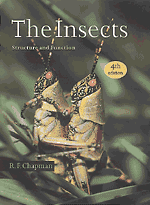Book contents
- Frontmatter
- Contents
- Preface
- Acknowledgments
- PART I The Head, Ingestion, Utilization and Distribution of Food
- PART II The Thorax and Locomotion
- PART III The Abdomen, Reproduction and Development
- 11 Abdomen
- 12 Reproductive system: male
- 13 Reproductive system: female
- 14 The egg and embryology
- 15 Postembryonic development
- PART IV The Integument, Gas Exchange and Homeostasis
- PART V Communication
- Taxonomic index
- Subject index
14 - The egg and embryology
Published online by Cambridge University Press: 05 June 2012
- Frontmatter
- Contents
- Preface
- Acknowledgments
- PART I The Head, Ingestion, Utilization and Distribution of Food
- PART II The Thorax and Locomotion
- PART III The Abdomen, Reproduction and Development
- 11 Abdomen
- 12 Reproductive system: male
- 13 Reproductive system: female
- 14 The egg and embryology
- 15 Postembryonic development
- PART IV The Integument, Gas Exchange and Homeostasis
- PART V Communication
- Taxonomic index
- Subject index
Summary
THE EGG
Insect eggs are typically large relative to the size of the females that produce them because they contain a great deal of yolk. It is generally believed that the eggs of Endopterygota contain less yolk and are smaller than those of Exopterygota (Anderson, 1972b). To some extent, this may reflect the types of ovariole they possess. For example, in two locust species which have panoistic ovarioles, each egg weighs about 0.5% of female weight; amongst insects with telotrophic ovarioles, the egg of Trialeurodes vaporarium is over 1% of the female weight, and that of Callosobruchus maculata (Coleoptera) 0.6%. By contrast, amongst insects with polytrophic ovarioles, comparable figures for Apis mellifera and Grammia geneura (Lepidoptera) are 0.07% and 0.11%, respectively.
Egg size is affected by factors other than the type of ovariole, however. Amongst Lepidoptera from temperate regions, species overwintering in the egg stage have larger eggs than species that overwinter in some other stage, and species feeding on woody plants have bigger eggs than those feeding on herbaceous plants (Reavey, 1992). Individual females of at least some butterflies lay smaller eggs as they grow older, and females of the cornborer moth, Ostrinia, lay smaller eggs if they do not receive adequate nutrition (Leahy & Andow, 1994). The parasitic Hymenoptera which lay their eggs in their hosts have very small eggs and this is also true amongst the Tachinidae (Diptera).
Insect eggs have a wide variety of forms. Commonly, as in Orthoptera and many Hymenoptera, they are sausage shaped (Fig. 14.10), but they may be conical, as in Pieris, or rounded, as in many moths and Heteroptera.
- Type
- Chapter
- Information
- The InsectsStructure and Function, pp. 325 - 362Publisher: Cambridge University PressPrint publication year: 1998
- 3
- Cited by



